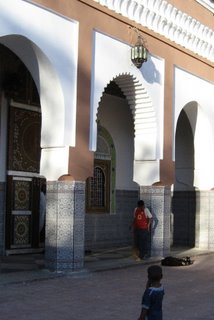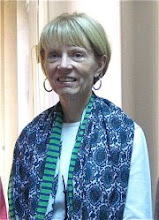
There is definitely a middle class aura or more to Rabat with its large community of foreign residents and status as a diplomatic center. However, it does have a medina (largely populated by poor people) and some historical sites. It's nice to be away from the hassle and pressure to buy of the more touristic sites like Marrakech and Fès. Today, I attended a series of lectures at the Moroccan-American Commission for Educational and Cultural Exchange. While the Berber language is ancient, it is in the process of standardization; and Moroccan Arabic is, more or less, a language in itself. Now that I have learned that the water is drinkable in the large cities, I have definitely taken advantage of the wonderful fruit available in Morocco. For a coffee break this morning, we had what Americans would call a fruit smoothie (drink), expresso coffee, and delectable Moroccan pastries. The lunch was also wonderful. Although I am back in Rabat, I included the picture on the left to indicate the varieties of Islam practiced in Morocco-largely Sufism and Sunni Islam. The picture displays a
zaouia (sanctuary) of a marabout (sage), closed to non-Muslims. The door has an intricately decorated archway of carved cedar and stucco. Seated in the courtyard of the sanctuary on the left were people who had come to be cured of various illnesses or for charity. I didn't want to take their picture.While I was there, a man came in with a bound goat-in the background, right of center. Such offerings are made in the belief that intercession by the spirit of the marabout (holy man) can assist people with their problems. A large number of families lived in underground tunnels nearby. While Morocco is seeking to use Turkey as a model, all but a few mosques (Casablanca's Hassan II, Rabat's Muhammad V Mausoleum,Rissani's zaouia of Moulay Ali Sherif-founder of the ruling dynasty, and the Moulay Ismail Mausoleum in Meknès) are closed to non-Muslims. The Tin Mal Mosque in the High Atlas, built by the religious reformer Ibn Tumart, is officially closed for restoration. However, the guardian is generally willing to show visitors around for a small tip. On a different note, I learned that with digital cinematography, films are being produced with Moroccan imagery, without anyone coming to Morocco-like Babel. Of course, many of the movies filmed in Morocco weren't about the country anyway.
 There is definitely a middle class aura or more to Rabat with its large community of foreign residents and status as a diplomatic center. However, it does have a medina (largely populated by poor people) and some historical sites. It's nice to be away from the hassle and pressure to buy of the more touristic sites like Marrakech and Fès. Today, I attended a series of lectures at the Moroccan-American Commission for Educational and Cultural Exchange. While the Berber language is ancient, it is in the process of standardization; and Moroccan Arabic is, more or less, a language in itself. Now that I have learned that the water is drinkable in the large cities, I have definitely taken advantage of the wonderful fruit available in Morocco. For a coffee break this morning, we had what Americans would call a fruit smoothie (drink), expresso coffee, and delectable Moroccan pastries. The lunch was also wonderful. Although I am back in Rabat, I included the picture on the left to indicate the varieties of Islam practiced in Morocco-largely Sufism and Sunni Islam. The picture displays a zaouia (sanctuary) of a marabout (sage), closed to non-Muslims. The door has an intricately decorated archway of carved cedar and stucco. Seated in the courtyard of the sanctuary on the left were people who had come to be cured of various illnesses or for charity. I didn't want to take their picture.While I was there, a man came in with a bound goat-in the background, right of center. Such offerings are made in the belief that intercession by the spirit of the marabout (holy man) can assist people with their problems. A large number of families lived in underground tunnels nearby. While Morocco is seeking to use Turkey as a model, all but a few mosques (Casablanca's Hassan II, Rabat's Muhammad V Mausoleum,Rissani's zaouia of Moulay Ali Sherif-founder of the ruling dynasty, and the Moulay Ismail Mausoleum in Meknès) are closed to non-Muslims. The Tin Mal Mosque in the High Atlas, built by the religious reformer Ibn Tumart, is officially closed for restoration. However, the guardian is generally willing to show visitors around for a small tip. On a different note, I learned that with digital cinematography, films are being produced with Moroccan imagery, without anyone coming to Morocco-like Babel. Of course, many of the movies filmed in Morocco weren't about the country anyway.
There is definitely a middle class aura or more to Rabat with its large community of foreign residents and status as a diplomatic center. However, it does have a medina (largely populated by poor people) and some historical sites. It's nice to be away from the hassle and pressure to buy of the more touristic sites like Marrakech and Fès. Today, I attended a series of lectures at the Moroccan-American Commission for Educational and Cultural Exchange. While the Berber language is ancient, it is in the process of standardization; and Moroccan Arabic is, more or less, a language in itself. Now that I have learned that the water is drinkable in the large cities, I have definitely taken advantage of the wonderful fruit available in Morocco. For a coffee break this morning, we had what Americans would call a fruit smoothie (drink), expresso coffee, and delectable Moroccan pastries. The lunch was also wonderful. Although I am back in Rabat, I included the picture on the left to indicate the varieties of Islam practiced in Morocco-largely Sufism and Sunni Islam. The picture displays a zaouia (sanctuary) of a marabout (sage), closed to non-Muslims. The door has an intricately decorated archway of carved cedar and stucco. Seated in the courtyard of the sanctuary on the left were people who had come to be cured of various illnesses or for charity. I didn't want to take their picture.While I was there, a man came in with a bound goat-in the background, right of center. Such offerings are made in the belief that intercession by the spirit of the marabout (holy man) can assist people with their problems. A large number of families lived in underground tunnels nearby. While Morocco is seeking to use Turkey as a model, all but a few mosques (Casablanca's Hassan II, Rabat's Muhammad V Mausoleum,Rissani's zaouia of Moulay Ali Sherif-founder of the ruling dynasty, and the Moulay Ismail Mausoleum in Meknès) are closed to non-Muslims. The Tin Mal Mosque in the High Atlas, built by the religious reformer Ibn Tumart, is officially closed for restoration. However, the guardian is generally willing to show visitors around for a small tip. On a different note, I learned that with digital cinematography, films are being produced with Moroccan imagery, without anyone coming to Morocco-like Babel. Of course, many of the movies filmed in Morocco weren't about the country anyway.


0 Comments:
Post a Comment
<< Home